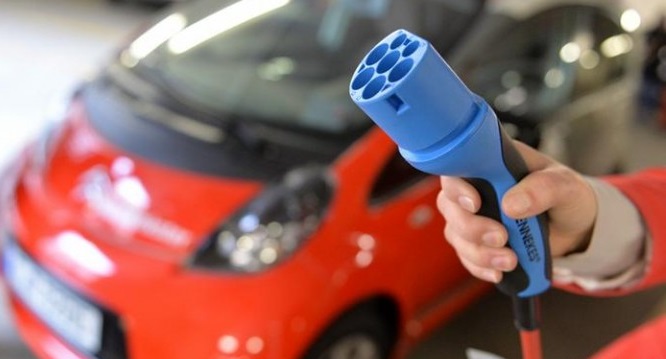Plug-in electric vehicles (PEVs) can serve in discharge mode as distributed energy and power resources operating as vehicle-to-grid (V2G) devices and in charge mode as loads or grid-to-vehicle devices.
It has been documented that PEVs serving as V2G systems can offer possible backup for renewable power sources, can provide reactive power support, active power regulation, load balancing, peak load shaving, can reduce utility operating costs and can generate revenue.
Now in a new study, researchers have found another potential advantage of using PEVs as sources of power for the grid: they can improve stability when the grid is subjected to large disturbances.
The researchers, Andrej Gajduk, et al., at the Macedonian Academy of Sciences and Arts in Skopje, Macedonia, and other universities, have published a paper on their findings in a recent issue of the New Journal of Physics.
They show that PEVs can even improve power grid transient stability, that is, stability when the power grid is subjected to large disturbances, including bus faults, generator and branch tripping, and sudden large load changes.
As the researchers explain, the last century saw the rise of two very large energy conversion systems: the electric utility system and the light vehicle fleet (cars, vans, and light trucks). Although the two systems were developed separately, the increase in electric vehicle use means that they will merge at some level in this century.
In a sense, all vehicles can be thought of as mobile storage systems, and have a total power capacity that is about 24 times larger than the power capacity of the entire electricity generation system in the US. By 2020, PEVs are expected to account for 1-2% of all vehicles in the US, potentially offering unprecedented benefits to the grid, which itself has essentially no storage.
“The power grid and electrical vehicle fleet are exceptionally complementary; in particular, the electric vehicle fleet can enhance power gird transient stability, which could represent a huge problem as renewable energy sources will dominate the future electric power grids,” coauthor Ljupco Kocarev, Professor at SS Cyril and Methodius University in Skopje, Macedonia, and at UC San Diego in the US.
In the new study, the researchers developed a control strategy in which PEVs regulate power to the grid by rapidly responding to large disturbances. In a simulation of the New England power system, 50,000 PEVs (representing 1% of all light vehicles in New England in 2020) each has the ability to exchange electricity with the grid at a maximum rate of 10 kW.
Surprisingly, the researchers found that increasing the percentage of PEVs in the simulation improves the stability benefit only up to about 4% PEV penetration. After this point, the benefits level off and then degrade rapidly after reaching 7% PEV penetration.
This negative effect is likely due to the PEVs overacting to the disturbance and injecting or withdrawing too much power from the grid. The results suggest that there is a limit to how much improvement can be achieved with this type of control. The researchers plan to investigate further improvements in the future.
“My future plans include developing and testing different control strategies, developing a rigorous framework to study both the steady-state and transient stability of the combined system power grid and electric vehicle fleet, and extending research methods to include the electricity market,” Kocarev said. “I believe that the V2G concept will enable a paradigm shift with synergistic benefits for the transportation and electricity sectors. Several V2G demonstrations are expected to be finalized in the near future, for example, by 2015 at the Los Angeles Air Force Base.”
Reference:
Publication: Andrej Gajduk, et al. “Improving power grid transient stability by plug-in electric vehicles.” New Journal of Physics. November 2014














Comments